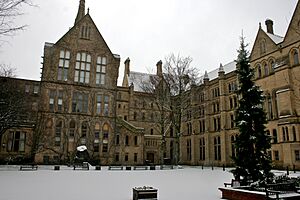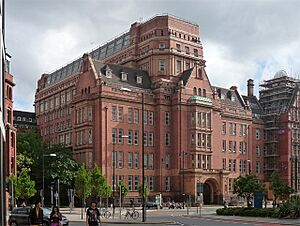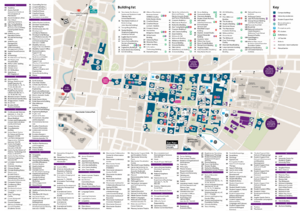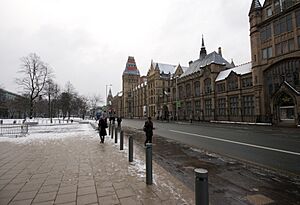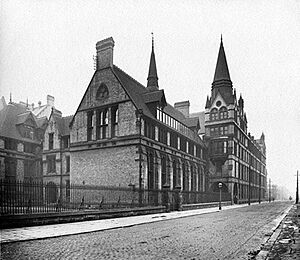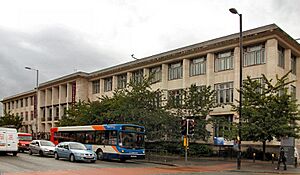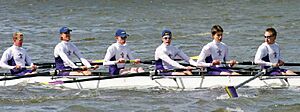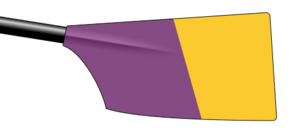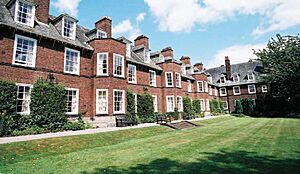University of Manchester facts for kids
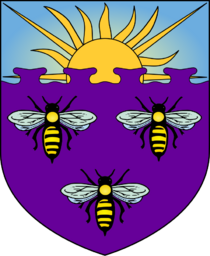
|
|||||||||||||||||||||
| Latin: Universitas Mancuniensis | |||||||||||||||||||||
|
Other name
|
Manchester University | ||||||||||||||||||||
|---|---|---|---|---|---|---|---|---|---|---|---|---|---|---|---|---|---|---|---|---|---|
| Motto | Latin: Cognitio, sapientia, humanitas | ||||||||||||||||||||
|
Motto in English
|
Knowledge, Wisdom, Humanity | ||||||||||||||||||||
| Established | 2004 – The University of Manchester Predecessor institutions: 1956 – UMIST (as university college; university 1994) 1904 – Victoria University of Manchester 1880 – Victoria University 1851 – Owens College 1824 – Manchester Mechanics' Institute 1824 – Royal School of Medicine and Surgery |
||||||||||||||||||||
| Endowment | £240.2 million (2024) | ||||||||||||||||||||
| Budget | £1.365 billion (2023/24) | ||||||||||||||||||||
| Chair | Philippa Hird | ||||||||||||||||||||
| Chancellor | Nazir Afzal | ||||||||||||||||||||
| President and vice-chancellor | Duncan Ivison | ||||||||||||||||||||
|
Academic staff
|
5,310 (2023/24) | ||||||||||||||||||||
|
Administrative staff
|
6,470 (2023/24) | ||||||||||||||||||||
| Students | (2015/16) 43,280 FTE (2015/16) |
||||||||||||||||||||
| Undergraduates | (2015/16) | ||||||||||||||||||||
| Postgraduates | (2015/16) | ||||||||||||||||||||
| Location |
,
England, United Kingdom
53°27′58″N 2°13′55″W / 53.46611°N 2.23194°W |
||||||||||||||||||||
| Campus | Urban and suburban | ||||||||||||||||||||
| Scarf |
|
||||||||||||||||||||
| Colours | Manchester Purple Manchester Yellow |
||||||||||||||||||||
| Affiliations |
|
||||||||||||||||||||
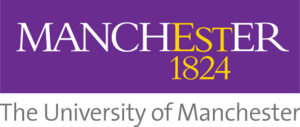 |
|||||||||||||||||||||
The University of Manchester is a large public research university in Manchester, England. Its main campus is just south of the city centre on Oxford Road. The university is known as a red brick university, which means it was one of the first universities founded in a major English city.
The modern University of Manchester was created in 2004. It was formed when two older institutions, the University of Manchester Institute of Science and Technology (UMIST) and the Victoria University of Manchester, merged together. These two had already been working together for about 100 years.
The university owns and runs important cultural places. These include the Manchester Museum, the Whitworth art gallery, and the John Rylands Library. It also operates the Jodrell Bank Observatory, which is a UNESCO World Heritage Site.
Manchester is one of the largest universities in the United Kingdom. It is very popular, receiving over 92,000 applications from students wanting to study there each year. The university is a member of the prestigious Russell Group of research universities. Over the years, 26 Nobel Prize winners have been students or staff at the university.
Contents
History of the University
How It All Began
The University of Manchester's story starts in 1824 with the Manchester Mechanics' Institute. This was a time when Manchester was the world's first industrial city. The famous chemist John Dalton and local businessmen wanted to make sure workers could learn about science. They believed this knowledge would help them improve their skills and invent new things. This institute later became UMIST.
Another key part of the university's history began in 1851 with Owens College. It was founded with money left by a textile merchant named John Owens. He wanted to create a college that would educate men regardless of their religion.
In 1873, Owens College moved to its current location on Oxford Road. It later became part of the federal Victoria University. When other colleges in Liverpool and Leeds became their own universities, it was renamed the Victoria University of Manchester in 1903.
For many years, the Victoria University of Manchester and UMIST worked closely together. In March 2003, they finally decided to join and become one single university.
A Hub for Great Discoveries
Before the two universities merged, they were already famous for science. It was at Manchester that Ernest Rutherford discovered that atoms have a nucleus. The world's first computer that could store a program, called the Manchester Baby, was also built here.
Many famous scientists have worked at Manchester. These include physicists like Niels Bohr, James Chadwick, and Hans Geiger. The mathematician Alan Turing, who was a key figure in the history of computing, also worked here.
The University Today
The current University of Manchester was officially launched on 1 October 2004. Queen Elizabeth II granted its official royal charter. The university quickly gained a strong reputation. It was named University of the Year by The Sunday Times in 2006.
The university is a world leader in research. In 2012, it was chosen as the home for the National Graphene Institute. Graphene is a super-strong, one-atom-thick material discovered at the university by Andre Geim and Konstantin Novoselov, who won a Nobel Prize for their work.
In recent years, students have held protests about rent prices and living conditions in university housing. These led to rent reductions and discussions between students and the university.
Campus and Buildings
The university's buildings are mixed in with the city of Manchester, so it feels like part of the city itself. The campus is split into two main areas: the Oxford Road Campus and the Sackville Street Campus. Student housing is located in three areas: City, Fallowfield, and Victoria Park.
Historic Buildings
Many of the oldest and most beautiful buildings are around the Old Quadrangle. These were designed in a Gothic style by architect Alfred Waterhouse. They include the John Owens Building, the Manchester Museum, and the grand Whitworth Hall, where students have their graduation ceremonies.
The Sackville Street Building is another impressive landmark. It is covered in decorative terracotta tiles and is now a listed building, meaning it is protected for its historical importance.
Cultural Places
The university is home to several amazing cultural institutions that are open to everyone.
- Jodrell Bank Observatory: Located in the Cheshire countryside, this observatory is a World Heritage Site. It has the giant Lovell Telescope, one of the biggest radio telescopes in the world.
- John Rylands Research Institute and Library: This beautiful library in the city centre looks like a castle. It holds rare and ancient books, including the oldest known piece of the New Testament.
- Manchester Museum: The museum has over four million objects from all over the world. You can see everything from ancient Egyptian mummies to a full-size skeleton of a Tyrannosaurus rex.
- The Whitworth: This is an art gallery famous for its collections of British watercolours, sculptures, and textiles. It is located in a park and has won awards for its design.
How the University is Organised
The University of Manchester is divided into three large subject areas called faculties.
Faculty of Biology, Medicine and Health
This faculty includes the School of Biological Sciences, the School of Medical Sciences, and the School of Health Sciences. The medical school is one of the largest in the country. Students learn in partnership with major hospitals in Manchester. The university was the first in Britain to offer a degree in Pharmacy.
Faculty of Science and Engineering
This faculty is split into the School of Engineering and the School of Natural Sciences. It covers subjects like computer science, chemistry, physics, mathematics, and engineering. The faculty is famous for its research in materials science, especially at the National Graphene Institute. The Jodrell Bank Centre for Astrophysics is also part of this faculty.
Faculty of Humanities
The Faculty of Humanities includes four schools covering a wide range of subjects.
- School of Arts, Languages and Cultures: Teaches subjects like history, music, drama, and modern languages.
- School of Environment, Education and Development: Focuses on geography, planning, and education.
- School of Social Sciences: Includes law, economics, politics, and sociology.
- Alliance Manchester Business School: A world-renowned business school.
Student Life
Students' Union
The University of Manchester Students' Union is the largest in the UK. It represents all students at the university. It runs clubs, societies, and events. It also offers support and advice to students. Instead of a single president, it is led by a team of eight officers who share the responsibility.
Sports and Clubs
The university has over 40 sports clubs, which are part of the Athletic Union. Thousands of students take part in sports like football, rugby, lacrosse, and water polo. The Manchester Aquatics Centre, built for the 2002 Commonwealth Games, is on campus and is used by the university's swimming and water polo teams.
Each year, Manchester competes against the universities of Leeds and Liverpool in the Christie Cup. This is one of the oldest university sports competitions in the country, dating back to 1886.
'University Challenge' Success
The University of Manchester has been very successful on the TV quiz show University Challenge. The university's teams have won the competition four times since 2006. This makes them one of the most successful universities in the show's history.
Student Housing
The university offers a variety of places for students to live. These are called halls of residence.
- City Campus: This includes halls like Whitworth Park, which has unique triangular-shaped buildings.
- Victoria Park Campus: This campus has more traditional halls, some of which offer meals. Hulme Hall is the oldest, first opening in 1887.
- Fallowfield Campus: This is the largest residential campus, located about two miles south of the main university site. It has a "student village" feel with large halls like Owens Park and Oak House.
Famous People from the University
Many famous people have studied or worked at the University of Manchester. In total, 26 Nobel Prize winners are linked to the university.
Famous scientists include John Dalton, who developed the modern atomic theory, and Ernest Rutherford, who discovered the atomic nucleus. More recently, physicist and TV presenter Brian Cox is a professor at the university.
Well-known actors who studied here include Benedict Cumberbatch and Toby Jones. Comedians Ben Elton, Ade Edmondson, and Rik Mayall also attended. The author Anthony Burgess was another famous graduate.
Public figures include Chaim Weizmann, the first president of Israel, and Michael D. Higgins, the current president of Ireland.
Images for kids
See also
 In Spanish: Universidad de Mánchester para niños
In Spanish: Universidad de Mánchester para niños
- Third-oldest university in England debate


